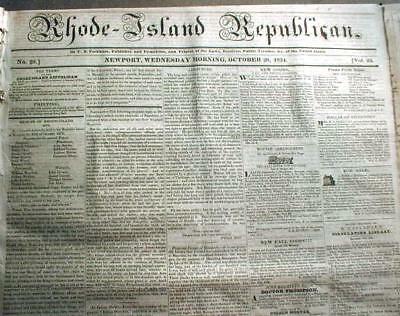-40%
1861 Illus newspaper CONFEDERATES BOMB FORT SUMTER STH CAROLINA Civil War Begins
$ 34.32
- Description
- Size Guide
Description
1861 Illustrated newspaper with a large centerfold, double-page engraving as well as detailed front-page headline report announcing that the CONFEDERATES BOMB FORT SUMTER, South CAROLINA and the Civil War Begins-
#1T-027
Please
visit our ebay store for printed on the front page other FANTASTIC Americana, Antiquarian Books and Ephemera.
SEE PHOTO-----COMPLETE, ORIGINAL NEWSPAPER, the
Harper's Weekly Illustrated Newspaper
(NY) dated April 27, 1861, with fantastic CIVIL WAR history!
Perfect for framing and display!
On Thursday, April 11, 1861, Confederate General P.G.T. Beauregard dispatched aides to Maj. Anderson to demand the fort’s surrender. Anderson refused. The next morning, at 4:30 a.m., Confederate batteries opened fire on Fort Sumter and continued for the next 34 hours. The firing on Fort Sumter marked the official start to the American Civil War. Anderson did not return the fire for the first two hours. The fort's supply of ammunition was not suited for an equal fight and Anderson lacked fuses for his exploding shells
— only solid shot could be used against the Rebel batteries. At about 7:00 A.M., Union Capt. Abner Doubleday, the fort's second in command, was afforded the honor of firing the first shot in defense of the fort.
The firing continued all day, although much less rapidly since the Union fired aimed to conserve ammunition. "The crashing of the shot, the bursting of the shells, the falling of the walls, and the roar of the flames, made a pandemonium of the fort," wrote Doubleday. The fort's large flagstaff was struck and the colors fell to the ground and a brave lieutenant, Norman J. Hall, bravely exposed himself to enemy fire as he hoisted the Stars and Stripes back up. That evening, the firing was sporadic with but an occasional round landing on or in Fort Sumter.
On Saturday, April 13, Anderson surrendered the fort. Incredibly, no soldiers were killed in battle. The terms of surrender, however, allowed Anderson to perform a 100-gun salute before he and his men evacuated the fort the next day. The salute began at 2:00 P.M. on April 14, but was cut short to 50 guns after an accidental explosion killed one of the gunners, Pvt. Daniel Hough, and mortally wounded another. Carrying their tattered banner, the Federal soldiers marched out of the fort and boarded a boat which ferried them to the Union ships outside of the harbor. They were greeted as heroes upon their return to the North.
Nobody could have imagined at the time that the Civil War would last more than four years, and cost the lives of more than 620,000 Americans.
Harper's Weekly (A Journal of Civilization) was a 16 page illustrated newspaper based in New York City. It was published by Harper & Brothers from 1857 until 1916. It sometimes had long articles on the political intrigues and scandals of the day. Following the successful example of the Illustrated London News, Fletcher Harper began publishing Harper’s Monthly magazine in 1850. The publication was more intent on publishing established authors such as Dickens and Thackeray, but was a great enough success to begin publishing the Harper’s Weekly illustrated newspaper in 1857.
By 1860 the Weekly’s circulation had reached 200,000. Among its recurring features were the political cartoons of Thomas Nast who was recruited in 1862 and would remain with the Weekly for more than 20 years. Nast was a feared caricaturist, considered by some the father of American political cartooning. He was the originator of the use of animals to represent the political parties—the Democrat’s donkey and the Republican’s elephant—as well as the familiar character of Uncle Sam.
So as not to upset its wide readership in the South, Harper’s took a moderate editorial position on the issue of slavery. For this it was called by the more hawkish publications “Harper’s Weakly.” The Weekly supported the Stephen A. Douglas presidential campaign against Abraham Lincoln, but as the American Civil War broke out, Lincoln and the Union received full and loyal support of the publication. Arguably, some of the most important articles and illustrations came from the Weekly’s reporting on the war. It published many renderings in woodcut, by artists such as Alfred Waud, Winslow Homer, and Thomas Nast which are now important archives.
The newspaper usually contained 8 pages of text and 8 pages of gorgeous woodcut engravings, highly prized today for their detailed illustrations of the American Civil War. The engravings are generally in 3 sizes: double page (DP - 21" X 16"), Full page (FP- 16" x 11") , and half page (HP- 10" x 8").
Good Condition, with moderate edge wear to front page.
This listing includes the complete entire original newspaper.
VINTAGE BOOKS AND FINE AR
T stands behind all of the items that we sell with a no questions asked, money back guarantee. Every item we sell is original printed on the date indicated at the beginning of its description, unless clearly stated as a reproduction in the header AND text body. U.S. buyers pay calculated priority postage which includes waterproof plastic and a heavy cardboard flat to protect your purchase from damage in the mail. International postage is quoted when we are informed as to where the package is to be sent. We do combine postage (to reduce postage costs) for multiple purchases sent in the same package.
We accept payment by PAYPAL.
W
e ship packages daily.
This is truly a piece OF HISTORY that YOU CAN OWN!
Powered by SixBit's eCommerce Solution


















